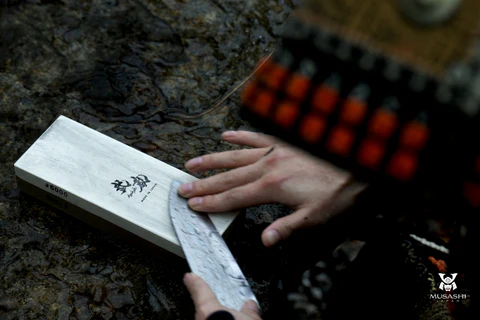Honing vs. Sharpening: The Key to Keeping Your Knives Razor-Sharp

Honing and Sharpening
Honing and Sharpening sound very familiar and similar, and you probably have thought that they mean the same thing for a long time. The thing is, they are actually very similar, but there are quite some subtle differences.
Honing
Basically, honing refers to the process in which the blade’s edge is realigned without removing any material. This helps maintain the blade’s cutting ability between sharpening sessions. Over time, the edge of a knife can get bent or misaligned due to use, and honing helps straighten it back to its proper position. However, honing does not actually sharpen a dull blade.
銳化
Sharpening is the process of removing material from the blade to create a new edge. It restores a dull blade by grinding and reshaping the edge, typically using a sharpening stone. Sharpening is a more intensive process than honing and is done less frequently.
When to Hone and Sharpen
Honing
Honing is required when the knife feels slightly dull but still cuts through certain materials. The blade might struggle a little with slicing, but it does not require excessive effort to cut. To check if your knife needs honing, hold it under a dim light—if the edge appears bent or slightly uneven (but not chipped), honing will help. Another test is to slice through a piece of paper; if the knife cuts but feels slightly misaligned, honing is the solution.
Honing realigns a knife’s edge to maintain its cutting performance. To start the honing process:
- Select a honing steel: Choose a steel that is harder than your knife blade.
- Positioning of the knife: Align your blade at a 10-20 degree angle (10-15° for Japanese knives, 15-20° for Western knives).
- Stroke: Run the knife from the base to the tip along the honing rod with light pressure, maintaining a consistent angle.
- Edge check: After honing, inspect if the knife edge is straightened.

銳化
Sharpening is required when the blade feels very dull, requires significant effort to cut, or starts tearing rather than slicing. If the knife has visible damage, such as chips or nicks, sharpening is necessary for better performance. You can also perform the tomato test—if your knife struggles to slice through the skin of a tomato, it’s time to sharpen.
To summarize the sharpening process, we have three key steps:
- Grinding – This is the initial stage where an abrasive material (such as a whetstone or grinding wheel) removes metal to create a new edge.
- Honing – After sharpening, a honing rod is used to realign the edge, ensuring optimal sharpness. (Steeling should be part of honing, not sharpening.)
- Stropping – The final step, where the blade is polished on a leather or fabric strop to refine the edge. Stropping does not remove burrs in the same way as sharpening but instead helps refine and smooth the cutting edge.
Why Are Honing and Sharpening Confused?
Honing and sharpening are often confused because both involve a similar motion when handling the blade, and both help maintain a knife’s cutting ability. However, their functions are different.
- Honing realigns the edge without removing material, keeping the blade effective between sharpening sessions.
- Sharpening removes metal to create a new edge and restore cutting performance.
Honing is usually done with a honing rod and should be performed regularly to retain precision, whereas sharpening requires abrasive tools and is done less frequently. Many users mistake these processes because they share a similar motion, but understanding their differences is crucial for proper knife maintenance.
Frequency
So, how often should you hone or sharpen your knife?
- Honing should be done before or after each use for professional chefs and at least two to three times a week for home cooks. This keeps the edge in its proper position and extends the time between sharpening sessions.
- 銳化 depends on the frequency of use. Ideally, for both professionals and home cooks, sharpening should be done once every 2 to 6 months using a proper whetstone. Professional chefs may sharpen their knives monthly, while home cooks may only need to sharpen them a few times a year.
Why Not Use Dull Blades?
Blades should always be honed or sharpened as needed because dull knives can be dangerous. A dull knife requires more force to cut, increasing the risk of slipping and causing injury. Additionally, it can damage the food being cut by crushing rather than slicing cleanly.
Tools Required for Honing and 銳化
For sharpening, various tools are available, including professional whetstones. Using the right sharpening tools ensures that your knife is properly maintained and retains its edge for longer.

Summary
銳化
- What it does: Removes metal to create a new edge using a whetstone or grinding tool.
- When to do it: When the knife feels dull, struggles to cut, or slips off food.
- How often: Every 2 to 6 months, depending on use. Frequent users (e.g., chefs) may sharpen monthly, while home cooks may only need it a few times a year.
Honing
- What it does: Realigns the edge without removing material, using a honing rod.
- When to do it: Before or after each use to maintain the edge.
-
How often: Daily or weekly, depending on usage.
Want more Japanese knife content? Create your Musashi Japan account today to stay updated on new arrivals, restocks, and more!

![Grape Kitchen Scissors 220mm Polish Forged Handmade-[Musashi]-[Japanese-Kitchen-Knives]](http://www.musashihamono.com/cdn/shop/files/Grape-Kitchen-Scissors-220mm-Polish-Forged-Handmade-Musashi-Japanese-Kitchen-Knives.jpg?crop=center&height=140&v=1734167139&width=140)

